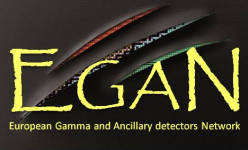Speaker
Elisa Rapisarda
(IKS Katholieke Universiteit Leuven)
Description
Extensive studies on Cu neutron-rich isotopes have been performed in recent years at REX-ISOLDE in the aim to investigate the nuclear structure in the vicinity of the N=40 sub-shell closure. In particular the study of odd-odd 68,70Cu nuclei was reported in [1] where for the first time low-energy Coulomb excitation measurements with isomeric radioactive post-accelerated beams were performed. For the case of 70Cu, a Iπ = 6- isomeric beam was used to study the multiplet of states (3-, 4-, 5-, 6-) arising from the π2p3/2⊗μ1g9/2 configuration. The isomeric nature of the 6- and 3- states was experimentally determined in previous work [2]. The beam was produced at ISOLDE, CERN by selective laser ionization technique and then post-accelerated by REX-ISOLDE to about 2.8 MeV/ nucleon. Gamma rays were detected with the MINIBALL high resolution Ge detector array. The 4- state of the multiplet was populated by Coulomb excitation and the reduced transition probability B(E2, 6-→4-) value was determined. The remaining member of the multiplet, the 5- state, was not observed in this experiment . To provide complementary information about the energy levels and reduced transition probabilities of the connecting transitions within the states of the multiplet, a new experiment was performed using a Iπ = 3- isomeric beam. Besides the known transition deexciting the 4- state [1], gamma rays of 511 keV were observed for the first time and were unambiguously associated to the 5- state deexcitation. This observation fixes the energy, spin and parity of this state, completing the low-energy level scheme of 70Cu. Moreover B(E2) values for all the possible E2 transitions within the multiplet are now precisely measured and will be compared with extensive shell-model calculations to get additional information on the underlying structure of the π2p3/2⊗μ1g9/2 multiplet. [1] I. Stefanescu et al. PRL98, 122701 (2007) [2] J. Van Roosbroek et al. PRC69, 034313 (2004)
Author
Elisa Rapisarda
(IKS Katholieke Universiteit Leuven)

